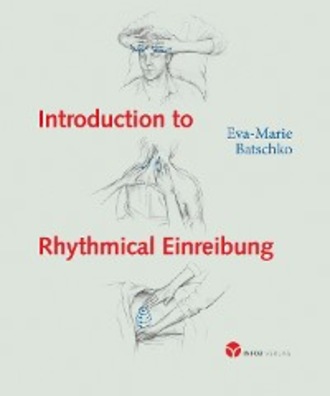
Полная версия
Introduction to Rhythmical Einreibung
Then the right hand covers the left hand and spreads the oil on the palms with a single stroke.
Only touch the patient with warm hands! The hands should be soft, supple and empathetic!
7. Outer posture of the practitioner
Stand freely (without leaning against or supporting yourself with anything). Flexible stance, slightly open towards the massage table, with loose, slightly bent knees.
Spread your weight evenly on both feet, with a slight, elastic flexion of the back to allow for inner resonance and free movement of the shoulders and arms (but do not bow!).
Distance to the patient neither too close (‘nose on the stomach’) nor too distant (‘head and back stretched backwards’) – this applies both physically and mentally.
Keep returning to an upright posture to connect with the cosmos that is radiating in from behind.
Movements are initiated between the should blades from the space at the back – the shoulder girdle and arms harmonise with the movement.
8. Inner attitude of the practitioner
‘There is only one temple in the world, and that is the human body. Nothing is more holy than this high form. Bowing before human beings is homage to this revelation in the flesh... We touch heaven when we feel a human body. ‘ (3)
Warm interest in and concern for the individual person (attentiveness). Being able to put oneself in second place (disregard of how we ourselves feel). ‘Control’ of thoughts and feelings. Inner calm and concentration during treatment (keeping ourselves centred).
Outward silence during treatment – conversation between hands and body (e.g. in the back Einreibung: ‘Speaking hands and listening back’ as well as ‘Listening hands and speaking back’).
Perception of the patient with all the senses (cultivate eye contact with the patient's countenance).
Connecting in awareness of a common sphere (awareness of surroundings).
Healer’s courage.
Do not forget humour – it helps you to ease difficult situations.
9. Archetypal image of Rhythmical Einreibung
‘The predisposition for the heart is created at the point where the blood can no longer continue to flow, is halted and dammed up; that is, the blood arrives and is brought to rest in being dammed up at, or rather on the head pole to form the heart. Since it cannot continue and has stopped, it reverses and travels back the way it has come along other capillaries. It disappears into the periphery where it originated, renews itself and starts on its way again from the beginning. All this means that, as described by morphodynamics, the conditions in the embryo are reversed.’(4)
This representation of heart development in the embryo describes the archetype of Rhythmical Einreibung.
Coming from the periphery, I dip into and gather the tissue, engaging it.
At the peak of this engagement I pause a little and let the movement continue to flow inwardly until it transforms itself into a release.
Through this greatest outward engagement, a supporting ‘gesture of levity’ is created inwardly.
This pause resembles the gesture of damming up in heart development where stillness and reversal simultaneously culminate.
Newly revived through the current reversed at the periphery, I release my hand from the engagement.
I let the return current quietly fade away into the periphery.
Thus in engagement there is an inhalation as far as an inner moment of reversal, followed in release by an exhalation as far as an outer moment of reversal.
These moments of reversal separate the two opposing currents from one another and simultaneously connect them.
In damming up and pausing, an organ is formed in the etheric that can have a healing effect on the living organism.
Further information on treatment can be found in the chapter ‘Questions and answers about Rhythmical Einreibung’.
The treatment positions are always described from the position of the patient.
In the drawings, ‘engagement’ is expressed by continuous lines while ‘release’ is represented by broken lines.
Einreibung of the back while sitting
The patient sits upright on the massage table or a chair; the feet rest on a solid support (e.g. a stool or the floor).
A pillow (possibly two) lies on the thighs covered with a towel; the underarms rest on it, slightly angled, so that the shoulders are relaxed and an upright posture is supported.
The entire upper body (including arms and hands) is wrapped in a blanket, the ends of which overlap behind the back.
For uncovering the back, the two ends are opened up to the left and/or right so that they hang loosely to one side, with the shoulder joints remaining covered.
1. Downstroke on the back
Standing behind the patient, I initiate the downstroke simultaneously with the heels of both hands directly to the left and right of the seventh vertebra (Vertebra prominens).
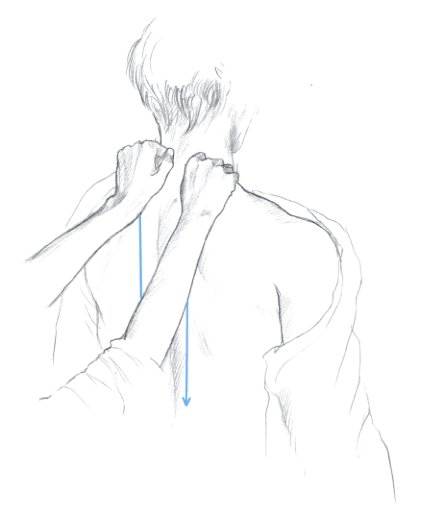
Ill. 1
Then I dip both hands – fingers pointing towards the head – lightly into the tissue and then stroke downwards along the back, parallel to the spine.
At the lower end of the back I release first the heel of the hands, then the middle of the hands and finally the finger pads from contact with the skin (without bowing forwards!).
I now hold the collected warmth lightly enclosed on the inside of my hands.
With this gesture, I return my hands to the starting point below the scapulae with a slight arc in the air, in order there to open both hands again after dipping in with the heels of the hands.
In this way the flow of warmth is not interrupted.
In the downstroke on the back, my left hand always flows to the left of the spine, the right hand to the right.
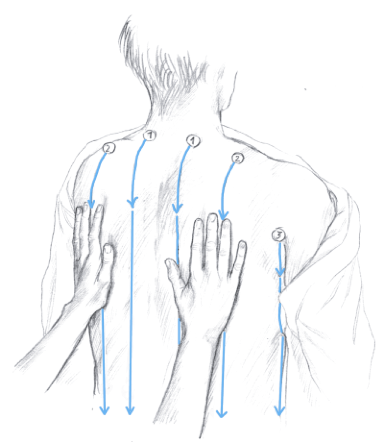
Ill. 2
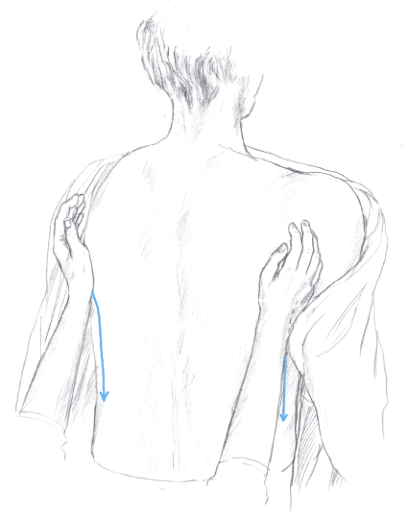
Ill. 3
This is done in three different, parallel movement flows, moving progressively further away from the spine laterally to the outside:
Stroke 1 moves inside close to the spine (but not touching it!).
Stroke 2 begins a hand’s width further outwards.
Stroke 3 moves so far out at the height of the armpits that the patient's sides are also touched. My hands always remain in flow and glide lightly following the shape of the body. In this dynamic they gradually turn a crescendo into a decrescendo.
EFFECT
The parallel nature of the back downstroke acts in a clarifying and ordering way, bringing about the perception of our own back.
The downward-flowing current of the hands creates a feeling of wanting to adopt an upright posture.
INDICATIONS
Acute life crises; psychophysical exhaustion; postural disorders; scoliosis; lordosis; kyphosis; apoplexy; paraplegia; obesity.
NOTE
The back downstroke is repeated, at most, three times, and only at the beginning of a back Einreibung.
2. One-handed circles on the back
Standing to the left of the patient, I first treat the right half of the back, then the left. The half of the back not in treatment is covered with a towel.
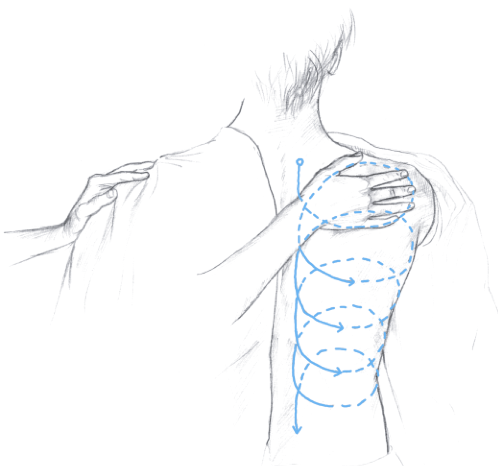
Ill. 4
While my right hand lightly describes counterclockwise circles, my left hand rests on the patient’s left shoulder. With the heel of the right hand I initiate the movement to the right of the seventh cervical vertebra (Vertebra prominens) and then slide, with the hand relaxed and with full skin contact, into the first circular form: my fingers follow the costal arch, such that the hand does not point horizontally to the side but rather slopes slightly downwards. In the first circular form, my hand creates an envelope as it swings warmly and softly around the shoulder joint, including it in the treatment. On the spine, down the erector spinae muscle, I dip with renewed emphasis into the downward movement and release again with the next circle.
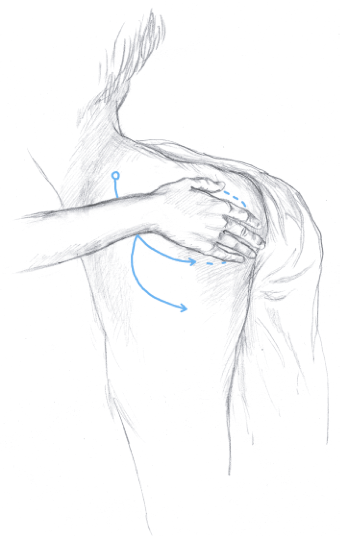
Ill. 5
The dynamic thus breathes between engagement (inside) and release (outside). Each new emphasis leads my hand further down – so that the previous circle partially overlaps, i.e. is still involved.
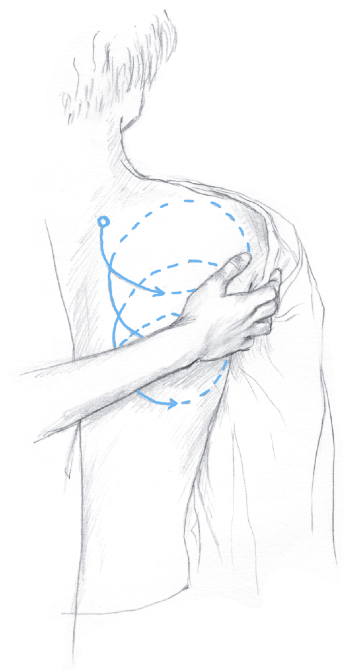
Ill. 6
In conclusion, I stroke the lumbar spine downward with the heel of my hand.
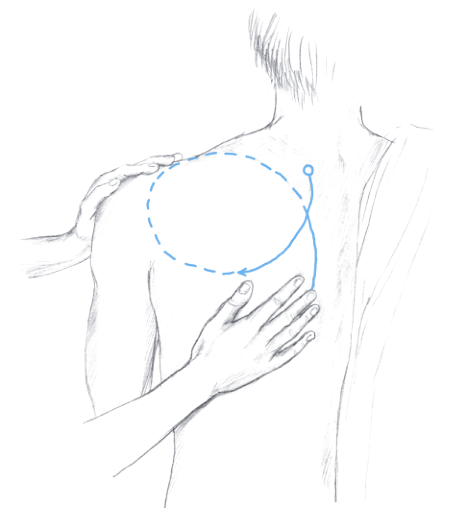
Ill. 7
On the left side of the back, the direction of the circle is clockwise. In the engagement stage, my fingers take over the function of the heel of the hand; thereafter the whole hand closely follows the course of the costal arch.
In order to achieve the right body contact, a good but relaxed (lateral!) stance is required. The whole process is repeated several times.
EFFECT
Calming; deepening of the breathing; a sense of space and rhythm and right-left perception can arise. The patient finds their balance.
INDICATIONS
Pneumonia prophylaxis; acute life crises; psychophysical exhaustion; apoplexy; paraplegia.
Particularly suitable for children and the elderly.
NOTE
The spine must not be touched or crossed!
3. The Good Night lemniscate
Remaining on the left side of the patient, the upper part of the back is covered again and the buttocks are uncovered roughly up to the coccyx.
My left hand rests lightly on the patient’s left shoulder during the entire treatment. Positioning my right hand underneath the sacroiliac joint (Articulatio sacroiliaca), I perform a small lemniscate that runs transversely across the back.
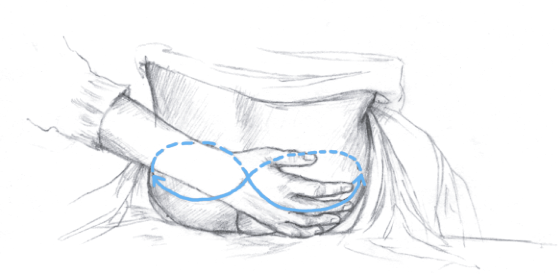
Ill. 8
My fingers always point to the right side of the patient. I start at the lemniscate’s center-point and follow the loop first to the right, then to the left.
Each loop begins with an emphasis of the lower arc. When immersed in the tissue, my hand – beginning with the tips of the fingers, then through the middle of the hand to the heel of the hand– nestles itself completely to the body’s shape.
My hand disengages from its emphasis at the outside right and glides quietly in the reverse order (heel of the hand– middle of the hand – fingertips) through the upper loop back to the intersection point. There it dips back into the tissue at the beginning of the left loop.
The emphasis is again released on the outside left. With the fingertips again leading – as in the beginning – the lemniscate is finally completed with the upper loop.
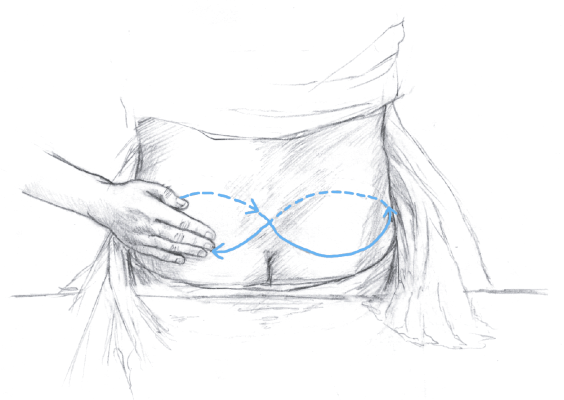
Ill. 9
My hand always remains in loose and warm contact with the skin. In its dynamic, the movement breathes between emphasis (below) and release (above).
After performing this several times, I finish the Einreibung after a right loop with a downstroke from the mid-point.
During this downstroke, too, my fingers point to the right side of the patient.
EFFECT
Relaxing; soothing; stimulating sleep. The warming of the gluteal muscles stimulates the flow of warmth into the feet.
INDICATIONS
Sleep disturbance due to cold feet; decubitus prophylaxis.
NOTE
The wrong emphasis (upwards) would stimulate kidney activity, i.e. excretion, too strongly!
Einreibung of the back in prone position
The patient lies covered on their stomach; a roll is placed under the arch of the feet so that they are not overstretched and the lumbar spine musculature is thus relieved. Immediately before the Einreibung, the back is uncovered; after the treatment it is covered again.
4. Downstroke on the back
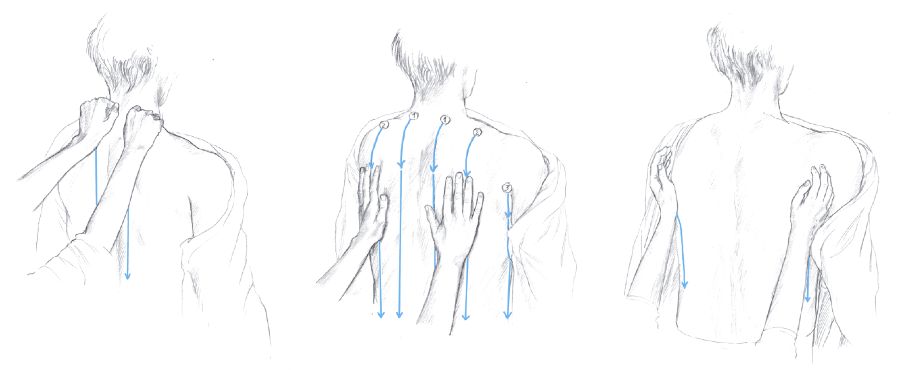
I now stand on the left side of the patient. In all other respects, the execution of the back downstroke with the patient in a prone position is identical to the back downstroke while sitting, as already described.
The effects and indications are also similar.
5. Two-handed circles on the back
Standing to the left of the patient, I place both hands between the shoulder blades and then circle them down the spine in continuous loops.
Both loops are phase-shifted, clockwise. My fingers always point towards the head.
In initiating the movement, my right hand moves to the upper right, the left hand moves to the bottom left.
During the circles, the previous loop is partially overlapped, that is, included. (However, the spine must not be touched or crossed!)
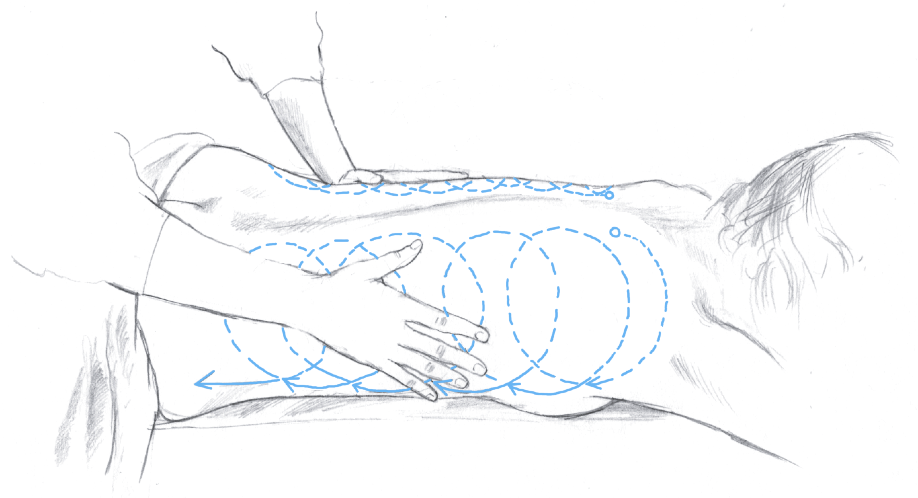
Ill. 10
In their dynamics, the circling movements reach their climax at the farthest point from the spine at the far outside on the sides of the back.
Thus my hand contact while enclosing the ribcage comprises the greatest engagement on the outside, while a supporting ‘gesture of levity’ arises on the inside:
For a moment, therefore, the flow of the motion comes to halt so that something ‘musical’ flows into the movement and the patient can feel a sense of inner expansiveness.
Then I release and finish the two circles by swinging my hands back to the spine. In conclusion, after several loops, I stroke the outer sides of the hip area downwards with both hands simultaneously. The whole execution is repeated several times.
EFFECT
Animation and stimulation of the breathing; harmonisation; a sense of expansiveness arises.
INDICATIONS
Asthma; respiratory disorders; neurasthenia; fears; fatigue; convalescence.
NOTE
The emphasis is created at the periphery of the back, not near the spine!
Variations of two-handed circles on the back
In a variation, the two-handed circles on the back can also be counterclockwise. Here my right hand starts towards the lower right, the left hand towards the upper left.
The emphasis does not change as a result; it still stays at the periphery of the back.
EFFECT
Enlivens and stimulates the circulation; a feeling of finding oneself again arises.
INDICATIONS
Circulatory disorders, listlessness, hyperactivity, hysteria.
6. The Good Morning lemniscate
In this Einreibung, the upper back is covered; the lower back and buttocks remain uncovered approximately to the coccyx.
I remain in my position on the patient’s left side. Throughout the treatment, my left hand rests lightly on the left side of the patient’s waist.
During the Einreibung, the fingertips of my right hand are placed to the right of the lower lumbar vertebrae, creating there a permanent centre of rest.
The actual movement comes from theheel of my hand which describes a ‘harmonious eight’ form below thefingertips. It starts in the middle with the loop to the bottom right, at the same time dipping in to engage.
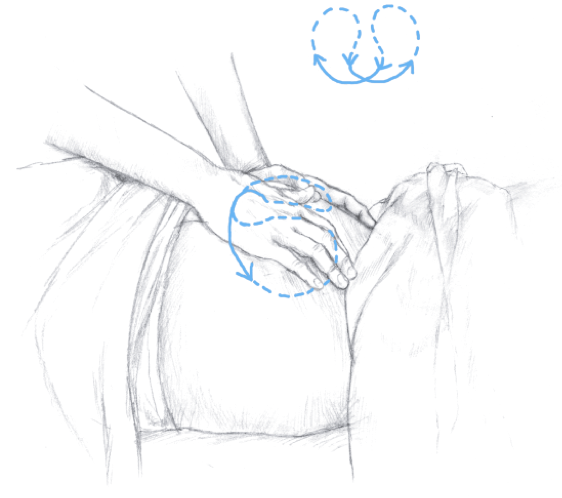
Ill. 11
This emphasis is released towards the outside halfway up the right loop. With warm skin contact, the heel of the hand now glides over the top inwards in the direction of the spine.
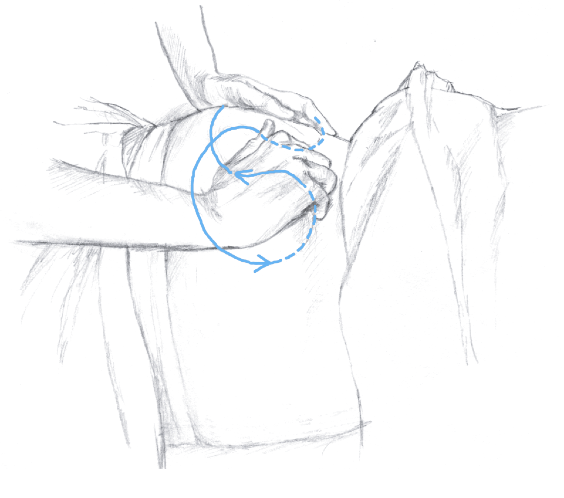
Ill. 12
On the arc downwards – away from the spine – I engage again and then slide theheel of my hand softly over the sacrum.
This engagement continues up half the height of the second loop. At the outer arc, I release it again until the left loop descends inwards towards the spine.
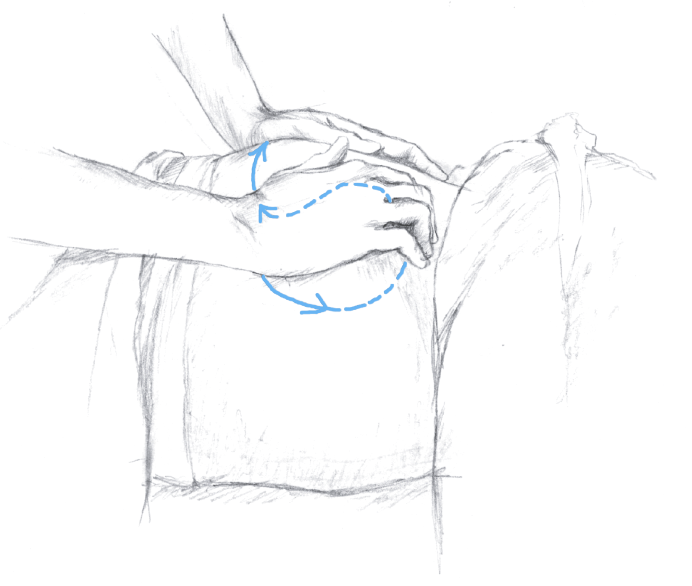
Ill. 13
There is renewed engagement on the inner arc before the ‘harmonious eight’ is finally completed at the point of intersection, and the patient becomes aware of the latter through an intense build-up of warmth (‘small fire’). In its dynamics, therefore, the movement breathes between emphasis (below) and release (above).
During emphasis, a warm, soft contact by the heel of the hand increases the intensity of the movement in this area. Having performed this several times, I finish the Einreibung after a right loop with a downstroke in the centre. During this downstroke, too, my fingers point towards the head.
EFFECT
Warming; waking; raising; activating; stimulating initiative.
INDICATIONS
Morning ‘grouchiness’; listlessness; depression; tired legs; sciatica.
NOTE
Use only in the morning! Do not perform energetically!
7. The Good Night lemniscate
Remaining on the patient’s left side, only the lower part of the back and the buttocks are uncovered, approximately to the coccyx.
Throughout the treatment, my left hand rests lightly on the patient’s left waist. Starting below the sacroiliac joint (Articulatio sacroiliaca), I use my right hand to make a small lemniscate that runs transversely to the back.
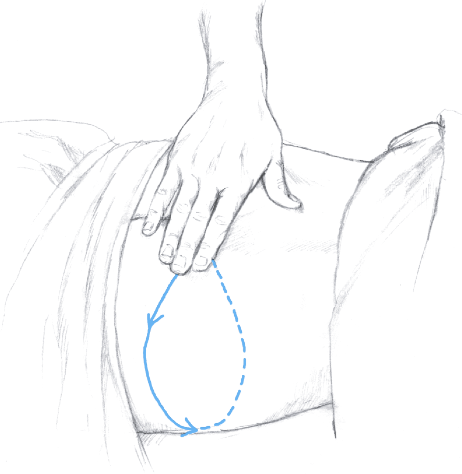
Ill. 14
My fingers always point to the right side of the patient.
I start at centre of the lemniscate, first following the loop to the right, then to the left. Each loop begins with an emphasis on the lower arc.
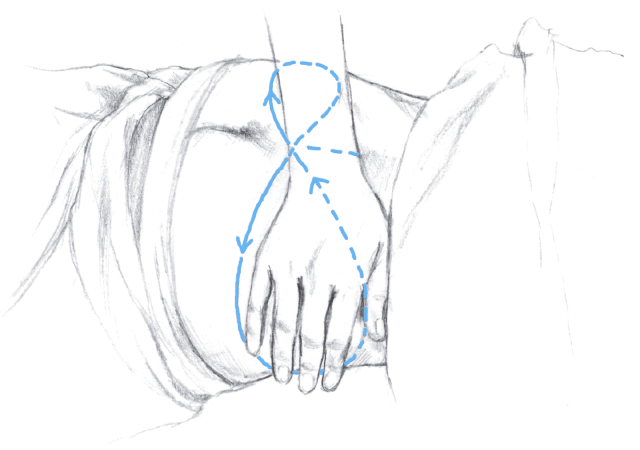
Ill. 15
When dipping into the tissue, my hand – starting with the fingertips through the middle of the hand to the heel of the hand – nestles completely into the shape of the body. On the outside right, my hand releases from its emphasis and glides smoothly in reverse order (heel of the hand – middle of the hand – fingertips) back to the crossing point via the upper arc.
There I dip back into the tissue at the beginning of the left loop.
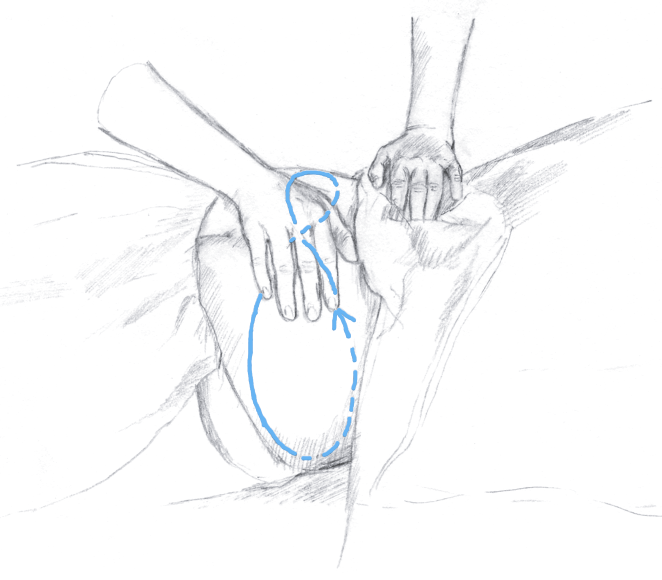
Ill. 16
With emphasis in the lower arc, my hand now glides to the patient’s left side. Led again by the fingertips – as in the beginning – the lemniscate is finally completed with an upper arc.
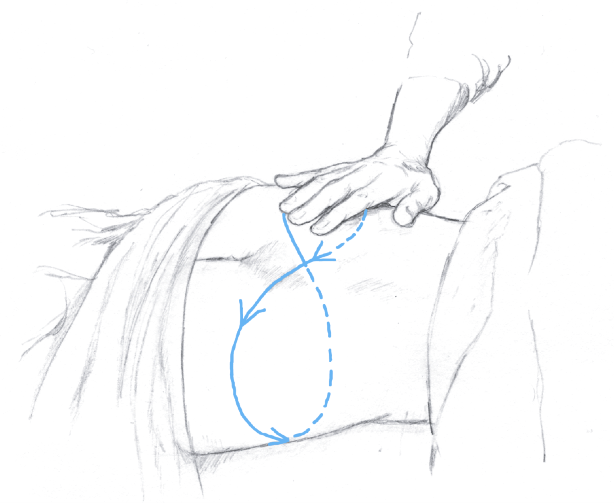
Ill. 17
My hand always stays in relaxed and warm contact with the skin. In its dynamics, the movement breathes between emphasis (below) and release (above).
Having performed it several times, I finish the Einreibung after a right loop with a downstroke in the centre.
During this downstroke, too, my fingers point to the right side of the patient.
EFFECT
Relaxing; soothing; promoting sleep. The warmth of the gluteal muscles stimulates the flow of warmth to feet.
INDICATIONS
Sleeplessness; mental states of excitement.
NOTE
Wrong emphasis (upwards) would result in overstimulation of kidney activity, i.e. excretion.
Einreibung of the shoulder girdle
8. Neck release (‘Christmas tree’)
The patient sits in an upright and relaxed position on a chair or on a massage table; the patient's feet rest on a firm surface (such as a stool or the floor).
A pillow on the lap allows the forearms to be supported; the neck and upper arms of the patient remain relaxed.
The patient is covered to the neck in a blanket; its upper ends overlap behind the back. When uncovering the back, the two ends are opened rearwards to the right and left, so that they hang down loosely on each side; the shoulder joints remain covered.
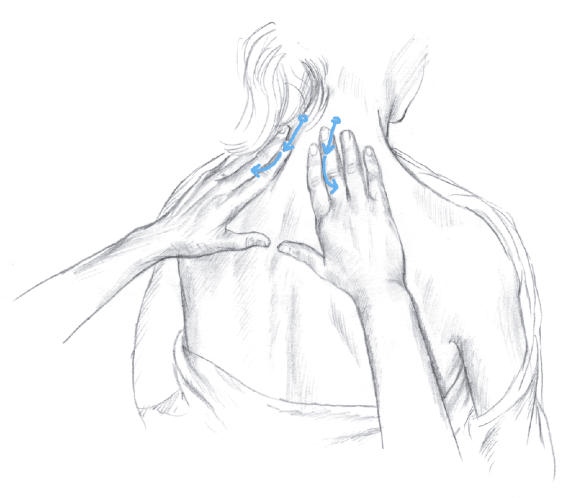
Ill. 18
Standing behind the patient, the fingertips of both my hands dip simultaneously into the tissue of the neck (trapezius muscle) to the left and right of the seventh cervical vertebra (Vertebra prominens).
My fingertips point diagonally upwards towards the spine, while the thumbs form a horizontal line without touching each other. The shape of a triangle is thus created between my hands.
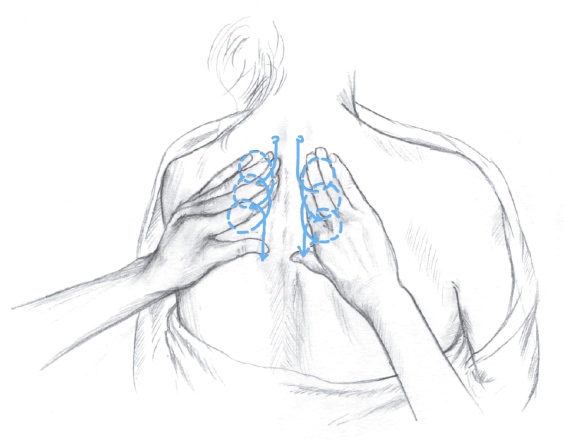
Ill. 19
Successively from the index finger to the little finger, I begin to engage the tissue until at last all fingers have full skin contact. As a result, the tissue bulges convexly outwards and ‘swells’ slightly.
At that moment my splayed thumbs dip in supportively between the shoulder blades and initially remain in that position. Without moving the wrists, my fingertips – carrying the tissue along – now flow in parallel to the spine towards the thumbs which, through their position, hold back the current coming from above, allowing it to peak through the engagement.
Perceiving this, both thumbs, together with the other fingers, slide in a slight downward arc at first to the inner edge of the shoulder blades.
In doing so, the fingers and thumbs release the emphasis so that the current can pour down from above in a liberating way.
Then my fingers, with light skin contact, glide upwards on the shoulder blades, completing the first circular motion.
The second immersion begins just below the first starting point at the level of the first thoracic vertebra. The third immersion is at the level of the second thoracic vertebra, etc. The last immersion is done such that the thumbs can still touch the bottom edge of the shoulder blades when stroking.
Thus there is a continuous circling process which is first emphasised in the area of the spine and then released again outwards.
In this way the area between the shoulder blades breathes deeply. Repeat the entire Einreibung several times!
EFFECT



